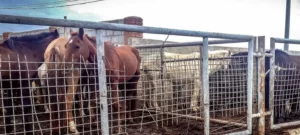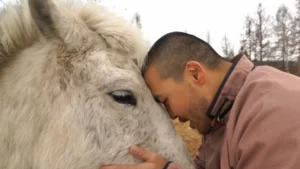Interview with historian and economist B. Naranbadrah
Сan you tell us about the history of your horse nursery?
-The turning point in my life happened at an international IT conference where I where was representing my company. That was a major conference held in Beijing in 2016 with companies from Asia, Middle East and Europe. The participants’ names were listed in the conference program and introductory brochure, and I got an idea to write down these names in calligraphic script and give them as a gift. That evening, I bought special paper, brushes and ink from the market and spent the whole night writing down the names of the participants in calligraphic handwriting. On the last day, I proposed my idea to the conference organizers, who enthusiastically agreed. I told everyone that I came from Mongolia, about how my country differs from the rest of the world, about the environment in which I was born and raised, and presented around my paper cards. Everyone got excited and applauded, and this mongolian guy, who sat modestly during the meetings, now attracted such attention. At one point, I am telling them: “while you are having your meal, let me sing a Mongolian folk song in the “urtyn” style”, and sang to them a beautiful song “Huurhun haliun” (about a young stallion- translator). Once again, the hall gotfilled with applause and surprise. Honestly, from that event on, my business flourished, and the environment in which I grew up, with its Mongolian way of life, household and horses, led to success. At some point, I began to think how to re-pay for such blessing, and decided to build a shelter for horses.
Our people know you as “Naranbadrah of the Horse Nursery.” It costs a lot of resources and money to buy back horses from a slaughterhouse and maintain a shelter for them. Do you have a business financing all this?
– I am a historian and economist, as for a private business, I had my own IT company that worked in Mongolia until 2016. Now I have taken my business abroad.

You mentioned earlier about being “different from the world”. In our time, with its drift to not look back and keep up with the world, is it worth talking about the differences?
– We misunderstand what “difference” means. As if this is what was and has passed, what has already become history, or which is no longer in use. What distinguishes our today’s way of life from the rest of the world is that difference. Since time when we were nomads, our difference from others meant horses. After all, other peoples reflect that Mongolia once conquered the world on horseback, that is their immediate association with Mongolia. Saving horses for me is like warming up my soul. And as “Eagle” TV broadcasted about our horse shelter, herders began to contact us in numbers, once there was even a thousand calls a day.
The question is how herders would make living if there is no business that needs their horsemeat. And what does it mean to “to put a calm horse into circulation”?
– Of course, you’re right. Currently, herders have no other way of earning money other than the meat business. But there is another major industry that can “to put a calm horse into circulation.” That is the tourism industry. We could organise a parade of ten thousand horses, for example. Looking for a solution, I once wrote an email to PETA, the world’s largest animal rights protection organization. They replied to me and even attached a report. They wrote: “If you could implement your initiative and involve the government, we are ready to help.”
In the United States alone there are 13,800,000 horse-lovers who sort of adopt these animals to simply keep them. Tourism here is developed in this direction too. Besides America, Europe has great potential for us as well with its millions of enthusiasts interested in saving horses. Germany, for example, carries the animal-friendly policy where 40 percent of their food is greens. So put simply, the love for animals has become a global trend. With our traditional respect for nature and animals, Mongolians were a nation that taught the world about love, but over the past 30 years we have lost our true identity, including respect for animals. We used to be those who taught the world to coexist in harmony and love for animals and nature, but we have no more this Mongolian essence. For example, today there are people who perceive horses simply as meat, and nothing else. There is no love but only emptiness in their souls. The high crime rate can be explained by this too. Honourable B.Rinchen once said these famous words: “the Mongolian “yes” is an oath.” But now the word “yes” is no more considered something imperative. By the way, in the United States, horses are protected by the animal protection law. Let me make one comparison here. According to statistics, 144 thousand horses are sent to slaughter every year in the world while in Mongolia this number reaches three hundred thousand slaughtered horses.
This is a large figure. But suppose we stop skinning horses and start organising the ten thousand horses festival. It will be a huge event, especially if aimed for the scale of the Brazilian carnival.
– The global body for Animal Protection (PETA) wrote to me: “If you realise your idea of stopping killing of horses and using them to develop the country’s tourism industry instead, we can help with free promotion. Leonardo DiCaprio could promote your event.”
Why did they specifically mention Leonardo DiCaprio?
– Leonardo DiCaprio collaborates with PETA being in charge of their Southeast Asia promotions. This is an opportunity to promote Mongolia for millions for free. The Italian branch of PETA sent in a letter explaining there possibility to send tourists who love horses and equestrian tourism, and even made a video with such intention. You mentioned the Brazilian carnival earlier. Every year, 4.9 million tourists visit Brazil just to see the carnival. The world will certainly be interested in our annual equestrian parade. We could even name the horse festival with a large army of warriors “General Subedai’s Tumen” (“tumen” is the noun for ten thousand – translator). General Subadai’s war tactics are a special topic in the world military history. Of course, such horse festival will not be only a parade. Domestic horse lovers, riders and herders will be able to trade and exchange their frisky horses, and a fair of mare milk, dairy products, horse equipment and an exhibition of equestrian culture can be organised as well. And then the government could also start taking part in the event, for instance, with an award ceremony for herders for their achievements, and so on.
On what basis did you calculate that the number of tourists could reach three million?
-The number is based on the numbers presented to me by PETA. Their letter included an estimate of “at least three million horseback tourists” if the horse parade becomes a reality.
“Love comes with realisation of responsibility “
Where and how to prepare so many tamed horses?
– In Mongolia, there is a great demand for horses with a calm demeanor, but there is no supply. But this can be resolved easily. For example, provincial governors could work with local schools and parents to build horse stables for local urban areas. let’s suppose there are 600 boys in a school in the Khan-Uul district. Let 100 of them get to know horses better and love them. Parents could use their yearly money they spend on horse meat per year to give their son a horse and keep it in that shelter. Specialists would keep the horses in a stall they themselves built together with the governor. Parents would bring their children for training and recreation. And thus a number of tamed horses would increase. Our herders in this case would prefer to bring their calm, aging horses to such stables, not to a slaughterhouse. As a number of such horses increases, the government could get involved and help with organizational issues. This all will surely take some time, but I think that holding a horse parade in four years is feasible.
More than half of Mongolians now live urban life. Many people are even unaware that horses can be part of children’s upbringing. Can you tell some real stories about how growing up through a close relationship with a horse affects a child’s development?
– There are many such stories. After that television program about our horse nursery, a man with a lot of experience in teaching horseback riding to children, came to us. That was B.Boldbaatar, President of the Mongolian Association of Stuntmen, and Chairman of the Mongolian National Association of Mounted Archery. This is the young man who organizes archery sessions working in the Jaarmag area. He congested me to join efforts because my aspirations and work were very close and understandable to him. There are also several young people who have adopted more than 50 children (the total number), and some of the adopted children are now young actors who have already starred in world-class films. One of them played in the movie “Mulan”. Several of our young people took part in filming of “Marvel” in Australia as stuntmen or substitute actors. I heard one of them even had to quarantine together with Tom Hanks. All these young people were trained by B. Boldbaatar. Bold told me an interesting story. One of his acquaintances came with his son, who got addicted to computer games and cola, says “keep my son close and make a man out of him.” Bold gave the boy a horse named “Moylhon” (a diminutive/affectionate of “hagberry” – translator) with the words: “Well, you will not ride this horse, just feed it, talk to it and walk together.” And now that boy is a stuntman for the Stuntmen Association. Children who are fond of horse archery, as well as their mothers and fathers, are so devoted to Bold, an enthusiastic guy who helps raising city children with love for horses and leads them to a brighter future. And the girls engage too, for example, the substitute actress of the main character in “Mulan” works closely with world-famous actresses and helps Mongolian children with grants and scholarships to study abroad.
How often do children come to your equestrian center?
-Parents started contacting us more often after that television interview, and children call as well. The number of children coming is increasing every day. I noticed something peculiar. Child’s attention seems to be 100 percent focused when a child is near a horse. There was a case at our horse shelter, one boy was preparing for the IELTS exams through the spring. He would ride away on a horse into grove and disappear. When we asked him what exactly he was doing there, he explained: “I hobble my horse, and he nibbles the grass next to me, and I would study. Under the sound of horse chewing, words are well remembered”. I remembered one interesting case that B.Boldbaatar told me about. He somehow helped a boy with his horse so much so that the boy began to relate to his horse in a completely different way. And once he said to his father: “I decided not to celebrate my birthday this year. Could you please use the money you’d spent on my birthday to buy fodder for my horse.” This is an example of the fact that with love comes with realization of responsibility. The original Mongolian parenting of a child through relationships with horses is still a reality in our countryside, and if we can connect this life practice with the upbringing of today’s urban children, or as we said earlier, bring this practice into a modern way, this can have a huge positive effect on the economy and society.

